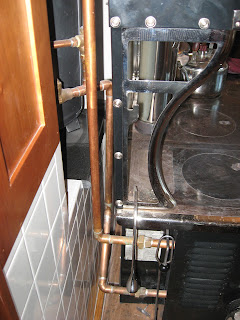Wait. Maybe I should rephrase that. What happened really wasn't new, but how it affected me was new.
Are you confused already? If not, you should be.
Let's see if I can explain this.
First, it is important to understand how the hot water system works. Cold water enters the middle of the boiler on its north side. Cold water exits the bottom half of the tank through the lower pipe on the south side and enters the waterfront (or water jacket) in the Margin Gem. The waterfront is a hollow box on the left side of the firebox where fire brick would ordinarily be.
 |
| An old picture of the Vaughn range boiler before it was connected to the Margin Gem. |
When a hot water faucet is opened somewhere in the house, the hot water exits the top of the boiler, passes through a mixing valve which cools it by adding cold water if necessary, and then travels to its point of use. The mixing valve allows us to manually adjust the maximum temperature of the hot water delivered throughout the house. We have always kept this at its highest setting, however.
We officially turned off our electric hot water heater for the winter season on Sept. 27th. Since then, all hot water used in our house has been heated by wood. Of course, at this time of year the temperature has not been cold enough to demand that a fire be burning in the range all the time. Having a fire in the morning to make breakfast and at night to cook supper is pretty much sufficient to supply us with enough hot water for our household needs unless we are doing quite a bit of laundry.
Because of this cyclical fire schedule, we often have times when the water in the Vaughn range boiler is hot, but the fire in the stove has been reduced to relatively cool coals.
This means that the water in the tank can be hotter than the water in the waterfront inside the firebox of the range since the firebox is lower than the tank and hot water rises.
 |
| A picture showing the height of the tank relative to the height of the waterfront in the firebox of the Margin Gem. |
So what happened on Sunday? Well, we were not home for noon dinner, so the breakfast fire was allowed to go out. After getting dirty while working outside in the afternoon, I needed a shower before we left for evening Bible study. There was plenty of hot water in the tank for my shower, but we were in a frost warning for Monday morning, so I knew we needed a fire to not only keep the house warm enough but also to heat the water for showers the next morning.
I re-lit the fire and then immediately jumped in the shower. The water in the boiler was at a comfortable temperature for showering since the fire had been been basically out for over six hours at that point. I didn't have any cold water turned on at all.
I could feel the water getting a little cooler throughout my short shower, but that is normal for both the electric and wood-fired water heating systems. Then toward the end of my shower, the water suddenly became quite hot. It took me a few seconds to realize that the water in the waterfront had finally become hot enough to restart the thermosiphon, and since I had only turned on the hot water valve in the shower, I was feeling the full effects.
The temperature change was not so extreme that I was burned or anything, and if we didn't have our mixing valve set so high, I probably wouldn't have even noticed it. However, I wanted to share this experience here so that if any other people use a water heating system that operates like ours, they can be aware that an event like this is possible.
If you heat your domestic hot water with a waterfront in a woodstove of any kind and have had a similar experience, please tell about it in the comments section below.

